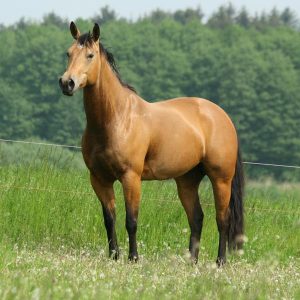
The Skinny on Fat
Packed with energy
Fat is an effective energy source for horses. Pound for pound, fats provide 2.25 times more energy than carbohydrates. In a natural state, horses consume only small amounts of fats, but they digest and absorb them well. Fats are broken down into fatty acids in the small intestine and stored as triglycerides in the adipose tissue of the body. Fat is utilized to fuel long-term, slow work.
Some fat is necessary
Fat is necessary for the proper absorption of the fat-soluble vitamins A, D, E and K. It provides horses with omega-3 (alpha-linolenic acid) and omega-6 (linoleic) fatty acids. These are known as essential fatty acids (EFA) because horses are unable to synthesize them in the body; hence, they must be provided in the diet. These EFAs perform numerous important functions within the body, including regulating inflammatory response and immune function.
Benefits of fat
- Feeding fat is a safe, effective way to meet the increased energy demands of modern horses. One of the goals when designing a feeding program is to keep the concentrate portion of your horse’s meal small. Adding fat to the diet can increase the energy content of the diet without increasing meal size. This lowers the risk of digestive disorders by allowing the concentrate portion of the meal to be fully digested before it passes into the hindgut. Improperly digested concentrates can ferment in the hindgut, disturbing the delicately balanced bug population. (See: Managing your Horse’s Bugs.)
- Fat is often referred to as a “cool” energy source. One of the advantages to utilizing fat for energy instead of carbohydrates is that fat produces less body heat when metabolized. Horses engaged in long-term work or those working in hot conditions benefit from this reduced heat production by using less sweat to cool their bodies. The term “cool” or “cold” can also be used to describe a feed’s effect on a horse’s temperament. Feeds high in soluble carbs tend to produce hormone surges that some researchers feel may cause horses to become more excited or “hot”-tempered. Fat burns at a slow, steady rate, reducing the hormone spikes. Horses utilizing fat for energy tend to be less excitable, so fats are known as “cool” energy sources.
- Horses fed fat accumulate less lactic acid in their muscles and maintain lower heart rates during work. Lactic acid accumulation leads to muscle fatigue and soreness. Horses utilizing fat as an energy source for long-term work often show increased stamina and tend to recover faster after work.
- Horses suffering from certain muscle disorders benefit from high-fat diets. Research has shown that horses suffering from problems such as RER (tying up) or PSSM (glycogen storage diseases) do not tolerate the soluble carbohydrates found in grains. Fats are an excellent source of energy for these horses. Horses suffering from metabolic disorders where insulin sensitivity is a problem also respond well to diets high in fat.
Protect against rancidity
There are different types of fats: some are saturated and some are unsaturated, and they can be of vegetable or animal origin. Horses can utilize many types of fats. Vegetable fats are higher in unsaturated fatty acids than animal fats. Unsaturated fats can become rancid when stored improperly. Rice bran, a common fat source, is heat-stabilized to prevent rancidity. Raw, unstabilized rice bran can turn rancid very quickly and is not recommended for horses. Some commercially available fats contain low levels of vitamin E, an antioxidant that prevents or delays rancidity. Supplements or feeds that contain fats should be stored in cool, dry places and used by their expiration dates.
Compare apples to apples
When shopping for high-fat feeds and supplements compare like with like. Many feed companies offer “high-fat” feeds containing fat levels ranging from 6% to 10% fat. High-fat supplements can contain much higher levels of fat, so check the label. If a supplement contains 20% fat, then one pound of supplement will supply 0.2 lbs of fat. If it contains 50% fat then one pound of supplement will contain 0.5 lbs of fat. You need to consider this when making cost comparisons. Always follow the feeding directions on the label and make all feed changes slowly.
Consult the experts
Be sure to consult your veterinarian or equine nutritionist for advice on feeding fat to your horse. They can help you choose the appropriate feeds and supplements to fit your horse’s individual needs.
Additional Resources
Fats Are an Effective Energy Source for Horses
Equi-Jewel®: What’s Inside the Bag
Tips for Feeding Special Needs Horses in the Winter
Catch Weight Loss in Your Horses Before It Becomes a Problem
Choosing Supplements for Senior Horses That Have Trouble Maintaining Weight
High-Energy Advantages
Hard Keepers
Performance Horses




2 Comments
I LOVE the Endure Extra. It really helps to put weight on the hard keepers. The best !
Pingback
[…] than 4-5 pounds per feeding. Feeding intervals should be at least 6 hours apart. Consider adding fat instead of carbohydrates to increase […]